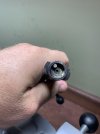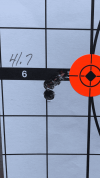If you develop your load correctly temperature shouldn't change your POI dramatically. The OCW method of load development is a way to make your load more stable.
In order to detect any pressure signs you have to have a baseline to compare your visual assessment on. As for the primer cratering, that could be common to that particular rifle. How do the primers look at a lighter charge? The still rounded edges of the primer is what I am looking at. I'd be more concerned if you had a flattened, extruded, or pierced primer. Definite pressure indicators.
Also I don't believe that the slight imaging of the ejector shown is a valid pressure indicator. I would expect a more visible image as a pressure sign such as a raised bump on the case head from the extractor. My edit: Another indication of excessive pressure is a "sticky" bolt.
From my experience almost all manual recorded maximums are well below the actual maximum pressure of most rifles. This is a liability limit by the manufacturer. I have reloading manuals from various bullet manufacturers (Hornady, Speer, Nosler) from 50+ years ago that have max loads for the same bullet/powder combination several grains higher than that of the latest manuals. You need to know what you're looking for in reading pressure indicators. And I'm not advocating that it is safe to exceed recommended maximums. I'm saying if you choose to do so you need to approach cautiously, in small increments, examining each and every fired case.
Here is a good article on reading pressure signs.
http://www.massreloading.com/reading_pressure_signs.html


